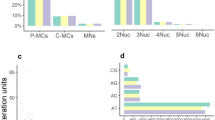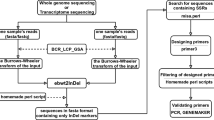Abstract
Over the last 20 years, microsatellites have revolutionized the study of cooperation in the social insects. The Polistes paper wasps have been an important model system for investigations of cooperative behavior. Recently, an expressed sequence tag (EST) library has been developed for P. metricus, allowing researchers to investigate the genetic basis of cooperative behavior in primitive social insect societies for the first time. We searched these freely available EST sequences for microsatellite motifs. This represents a relatively new approach to the development of microsatellite loci that allows for the development of a greater number of loci at less expense. We designed 32 PCR primer pairs, of which 23 amplified PCR products and 18 were polymorphic. These loci exhibited high levels of polymorphism, comparable to anonymous loci isolated via screens of partial genomic libraries. Thus, they are appropriate for population genetic studies as well as the reconstruction of colony genetic structure. A screen of the entire EST database found a total of 708 di-, tri-, tetra- and penta-nucleotide repeats with large repeat units typical of polymorphic loci and at least 30 bp of flanking sequence for primer design. This pool of potential loci represents a new genetic tool for P. metricus, as well as Polistes more generally, as there is great promise for cross amplification in other species.


Similar content being viewed by others
References
Arevalo E., Strassmann J.E. and Queller D.C. 1998. Conflicts of interest in social insects: Male production in two species of Polistes. Evolution 52: 797-805
Batra R., Charizanis K. and Swanson M.S. 2010. Partners in crime: bidirectional transcription in unstable microsatellite disease. Hum. Mol. Gen. 19: R77-R82
Borrone J.W., Brown J.S., Tondo C.L., Mauro-Herrera M., Kuhn D.N., Violi H.A., Sautter R.T. and Schnell R.J. 2009. An EST-SSR-based linkage map for Persea americana Mill. (avocado). Tree Genetics & Genomes 5: 553-560
Carpenter J.M. 1996. Distributional Checklist of Species of the Genus Polistes (Hymenoptera, Vespidae, Polistinae, Polistini). American Museum of Natural History, New York
Ellis J.R. and Burke J.M. 2007. EST-SSRs as a resource for population genetic analyses. Heredity 99: 125-132
Henshaw M.T. 2000. Microsatellite loci for the social wasp Polistes dominulus and their application in other polistine wasps. Mol. Ecol. 9: 2155-2157
Hudson M.E. 2008. Sequencing breakthroughs for genomic ecology and evolutionary biology. Mol. Ecol. Res. 8: 3-17
Hunt J.H., Kensinger B.J., Kossuth J.A., Henshaw M.T., Norberg K., Wolschin F. and Amdam G.V. 2007. A diapause pathway underlies the gyne phenotype in Polistes wasps, revealing an evolutionary route to caste-containing insect societies. Proc. Natl Acad. Sci. USA 104: 14020-14025
Hunt J.H., Wolschin F., Henshaw M.T., Newman T.C., Toth A.L. and Amdam G.V. 2010. Differential gene expression and protein abundance evince ontogenetic bias toward castes in a primitively eusocial wasp. Plos One 5: e10674
Lewis P.O. and Zaykin D. 2001. Genetic Data Analysis: Version 1.0 (d16c). Free program distributed by the authors over the internet from http://lewis.eeb.uconn.edu/lewishome/software.html.
Miller S.A., Dykes D.D. and Polesky H.F. 1988. A simple salting out proceedure for extracting DNA from human nucleated cells. Nucl. Acids Res. 16: 1215-1215
Queller D.C., Strassmann J.E. and Hughes C.R. 1993. Microsatellites and kinship. Trends Ecol. Evol. 8: 285-288
Ranum L.P.W. and Day J.W. 2002. Dominantly inherited, non-coding microsatellite expansion disorders. Curr. Opin. Genetics Dev. 12: 266-271
Reeve H.K. 1991. Polistes. In: The Social Biology of Wasps (Ross K.G. and Matthews R.W., Eds). Cornell University Press, Ithaca, pp 99-148
Strassmann J.E., Solís C.R., Peters J.M. and Queller D.C. 1996. Strategies for finding and using highly polymorphic DNA microsatellite loci for studies of genetic relatedness and pedigrees. In: Molecular Zoology: Advances, Strategies and Protocols (Ferraris J.D. and Palumbi S.R., Eds). Wiley-Liss, Inc., New York, pp 163-180, 528-549
Strassmann J.E., Peters J.M., Barefield K., Solis C.R., Hughes C.R. and Queller D.C. 1997. Trinucleotide microsatellite loci and increased heterozygosity in cross-species applications in the social wasp, Polistes. Biochem. Gen. 35: 273-279
Tibbetts E.A. 2007. Dispersal decisions and predispersal behavior in Polistes paper wasp ‘workers’. Behav. Ecol. Sociobiol. 61: 1877-1883
Toth A.L., Varala K., Newman T.C., Miguez F.E., Hutchison S.K., Willoughby D.A., Simons J.F., Egholm M., Hunt J.H., Hudson M.E. and Robinson G.E. 2007. Wasp gene expression supports an evolutionary link between maternal behavior and eusociality. Science 318: 441-444
Toth A.L., Varala K., Henshaw M.T., Rodriguez-Zas S.L., Hudson M.E. and Robinson G.E. 2010. Brain transcriptomic analysis in paper wasps identifies genes associated with behaviour across social insect lineages. Proc. R. Soc. B - Biol. Sci. 277: 2139-2148
Vigouroux Y., McMullen M., Hittinger C.T., Houchins K., Schulz L., Kresovich S., Matsuoka Y. and Doebley J. 2002. Identifying genes of agronomic importance in maize by screening microsatellites for evidence of selection during domestication. Proc. Natl Acad. Sci. USA 99: 9650-9655
Yevgeniy G., Rodriguez A. and Benson G. 2006. TRDB - The Tandem Repeats Database. Nucl. Acids Res. 35 (suppl 1): D80-D87
Acknowledgments
The authors thank The Hudson lab at the University of Illinois, Urbana-Champaign for early access to assembled contig sequences and the Statistical Consulting Center at Grand Valley State University for statistical advice. This work was supported by grant #IOS-0803317 from the National Science Foundation as well as grants from the Center for Scholarly and Creative Activity at Grand Valley State University.
Author information
Authors and Affiliations
Corresponding author
Electronic supplementary material
Below is the link to the electronic supplementary material.
Rights and permissions
About this article
Cite this article
Henshaw, M.T., Toth, A.L. & Young, T.J. Development of new microsatellite loci for the genus Polistes from publicly available expressed sequence tag sequences. Insect. Soc. 58, 581–585 (2011). https://doi.org/10.1007/s00040-011-0164-z
Received:
Revised:
Accepted:
Published:
Issue Date:
DOI: https://doi.org/10.1007/s00040-011-0164-z




